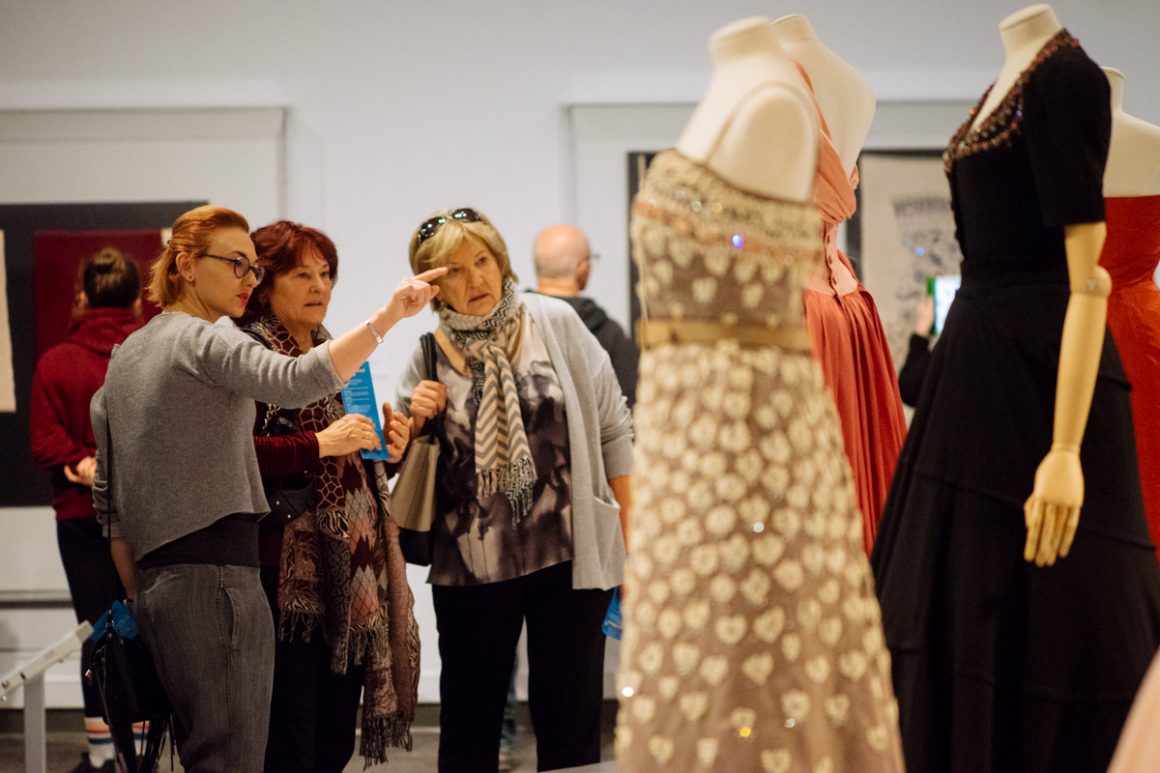
Glenbow Museum holds Community Day
By Shanaz Pasha, March 8 2019 —
The Glenbow Museum held its annual Community Day event on March 3, granting free admission for all museum guests for the day. This event allowed the entire community to experience the exhibitions and pieces on display at the site such as works that address Indigenous identity, as well as a well-publicized exhibition featuring fashion designer Christian Dior.
At Play by Calgary painter Chris Cran — exhibited as part of the One New Work series — shows distinct works that look as though they’ve been created by different artists. His piece “Eight Drawings” is an ink-on-paper abstract, gestural work that emphasizes tool marks, scrapes and squiggles that have a raw, almost messy quality to them. In stark contrast, his work “Paintings on Paper” looks like silkscreens or linocuts. It is clean, precise and illustrative with subjects that are nonetheless expressive.
Confluence by Meryl McMaster features portraits of projections of Indigenous historical photos onto the white-painted bodies of herself and her father. The photographs show layers of human features that convey meaning of biculturalism, representation of Indigenous people and their relationships with their contemporary Indigenous identity. The series is poignant and stakes a considered balance of both concept and use of media. Though the rest of the exhibit was visually striking and full of symbolism, I was often left with questions unanswered and wondered about the context and meaning in some of the photographs.
On Location: Artists Explore a Sense of Place, curated by Sarah Todd, is an exhibit centered on the idea of place and its relation to identity. It features an array of work by artists including Ron Moppett, Annie Pootoogook and Maxwell Bates. It is a vibrant and colourful exhibition, with a mixture of sombre works like Jeff Davis’s black and white photographs and satirical works like “Asparagus Column” by Victor Cicansky, which shows a Doric column growing into green asparagus shoots at its top.
Picturing the Northwest is a more familiar type of museum exhibition, featuring landscapes that depict scenes of canoes, hunting, mountains, horses, buffaloes and farming. What is astonishing about this collection is how similar in style, subject and aesthetic the paintings are — even though they’re by different artists — highlighting the differing approaches of the featured epochs in subject matter and cultural context.
Also seemingly familiar is the layout of Albertine Crow Shoe’s installation The Blackfoot People’s Way of Life is Still Strong, in which her contemporary designs are placed among the artifacts that inspired her. They are laid out in traditional museum fashion, behind glass with museum object labels depicting the past with the present. The contemporary designs, often made with materials such as silver, carry traditional symbolism. This symbolism is used in “Blackfoot Flowers”, an intricate silver and gold necklace, echoing the floral beading pattern of the artifacts that inspired it. Each artwork is a presentation of Blackfoot traditions carried forward in contemporary culture. Though the works, like the culture, may look different in contemporary times, the lineage of heritage is evident.

A small exhibit of works by Catalan artist Antoni Tapies shows several bold, expressive prints that look purely abstract, but signify the oppression of the Catalan people and their culture under the rule of dictator Francisco Franco. Prints 1948–1976 shows modern, formal works emoting post-war sentiments, created in a highly political context. It’s refreshing to see different approaches in modern and contemporary history that address politics, identity and our sense of place in the world.
The much-talked-about Christian Dior exhibit does not disappoint with its selection of clothing by the celebrated haute couturist, highlighting stunning pieces and samples of beaded patterns. The exhibit celebrates beauty and femininity but focuses on the context in which the Dior aesthetic arose, namely as a reaction to the loose-fitting, relaxed clothing that had characterized women’s fashion in the decades before Dior’s rise. It is commented in the piece that Dior’s designs “made women feel like women again” after the Second World War. The heightened skinny waists and metal boning corset constructions of designs offer a romanticized view of how women may have felt in la belle époque, glossing over the fact that women didn’t even have the right to vote in this time.
Even Dior cannot escape the practical needs of womenswear in spite of the romanticized aesthetic of the clothes and their construction. The pieces make use of utilitarian fabrics, solid colours and clothes that adhere to the mobility of women’s lives, concepts which are hard to grasp until we see the clothes in person. The couture installation set against the backdrop of men and women mostly dressed in jeans and T-shirts creates a strong juxtaposition. While most of the visitors are attending the Glenbow Museum for the Dior show, it’s a pleasant surprise to have an opportunity to see a variety of art that is both thought provoking and visually stimulating, with works from home and abroad.
The Glenbow Museum is running the Christian Dior exhibition until June 2, 2019. More information about current exhibitions and events at the Glenbow — as well as information about ticket prices — can be found on their website.
